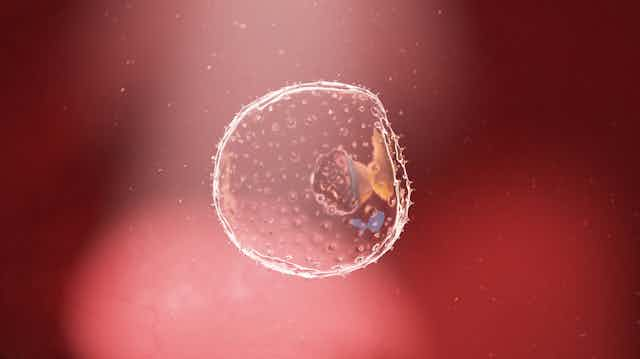Scientists recently announced that they have developed embryo models using just stem cells. No sperm or egg cells (oocytes) were involved.
These new research findings were presented by Professor Magdalena Żernicka-Goetz of the University of Cambridge and the California Institute of Technology at the annual meeting of the International Society for Stem Cell Research in Boston.
The work, which is yet to be published in a journal, has prompted a debate about the potential use of embryo models derived from stem cells – known as stem-cell-based embryo models – in research.
So what exactly are these embryo models and how might they advance science?
First, they differ from embryos created by fertilisation, although we don’t yet understand the full extent of the differences from a biological or moral perspective.
Normal embryonic development starts when a sperm fertilises an egg, after which embryos complete a number of cell divisions (cleavage) over about four days. The cells become “squeezed” together in a process called compaction before making a structure called a blastocyst by day five.
The blastocyst is a key stage because it’s around this time that the embryo starts implanting in to the womb – the start of pregnancy. Over the days that follow, the embryo undergoes further development, generating different cells that will ultimately become a fully formed baby.
By about 14 days, the embryo has undergone a process called gastrulation, which forms a structure called the “primitive streak”, setting up the basic pattern of the body.
By contrast, embryo models are created directly from stem cells – either embryonic stem cells previously isolated from an embryo or pluripotent stem cells (cells that have been reprogrammed under laboratory conditions to become stem cells).
Recent research from a number of groups has shown that stem cells can, under special laboratory conditions, be persuaded to form a structure that resembles a blastocyst. These structures are what we’ve come to call “stem-cell-based embryo models”.
Żernicka-Goetz described culturing the embryo model to a stage of development just beyond the 14-day stage of gastrulation.
An exciting prospect for science
Research with fertilised embryos is a carefully regulated area of science. Notably, research using human embryos must stop no later than the point of 14 days development, before the primitive streak emerges.
This restriction has inevitably limited research into the crucial stage of development when the embryo would implant in to the womb if it was in a body. We know remarkably little about this step in human development. Embryo models could help us understand infertility and early pregnancy loss.
While embryo models are not the same as fertilised embryos, their similarities mean they could be used to study aspects of reproduction that scientists currently can’t investigate.
To realise the potential of these models, we need to discover the similarities – and differences – between embryo models and regular embryos.
For example, the fact that embryo models don’t require eggs or sperm may mean that they are different to fertilised embryos. Also, circumventing the cleavage steps might signify important biological differences between embryo models and fertilised embryos.
Currently, there is no evidence that these are able to develop in the womb. A recent study in monkeys found that embryo models derived from monkey stem cells were unable to develop beyond a few days in the womb.
We don’t yet know whether this inability to develop is an intrinsic limitation of embryo models or technical limitations that may be overcome by improved understanding and better methods.
But the transfers did elicit a pregnancy-type response in the female animals, indicating the value of embryo models in studying the early stages of implantation.
Ethics and regulation
There are robust governance frameworks and laws in the UK for research with fertilised embryos. However, embryo models don’t fit neatly in to this system because the law was drafted before the technology was developed. They’re not the same as fertilised embryos – and are probably not “embryos” at all under the legislation.
Even though embryo models are not fertilised embryos and don’t have a beating heart or the beginnings of a brain, research must be responsibly conducted and the implications carefully considered.
At an international level, guidance for research with embryo models has been proposed by the International Society for Stem Cell Research. An important step will be to implement the international guidance at a national level.
In the UK, scientists, lawyers and ethicists are already working on new guidelines on how to work with embryo models, which will hopefully give the public confidence in this work.
Read more: First working eggs made from stem cells points to fertility breakthrough
We have learned from past experience that we need to scan the horizon for potential scientific advances so that we can prepare to introduce them safely and responsibly.

